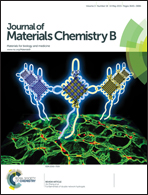A mussel-inspired chitooligosaccharide based multidentate ligand for highly stabilized nanoparticles†
Abstract
Inspired by the adhesion behaviors of mussels, we synthesized a chitooligosaccharide (COS) based multidentate ligand (ML) for preparing robust biocompatible magnetic iron oxide nanoparticles (IONPs). The COS was modified with mussel adhesive protein (MAP) mimetic multiple catechol groups and branched poly(ethylene glycol) moieties, which can not only strongly bind to IONPs through multiple catechol groups, but also afford IONPs with good colloidal stability and biocompatibility due to PEG integrated into the COS coating. The resultant ML-stabilized IONPs consist of single nanoparticles coated with ML shells and exhibited high dispersion stability in aqueous solution for a wide range of pH and concentrated salt solutions. The potential of ML-stabilized IONPs as contrast agents for T2-weighted magnetic resonance imaging was demonstrated by conducting in vivo imaging and relaxivity measurements. The ML-stabilized IONPs are therefore expected to be useful for magnetic resonance imaging under physiological conditions.


 Please wait while we load your content...
Please wait while we load your content...